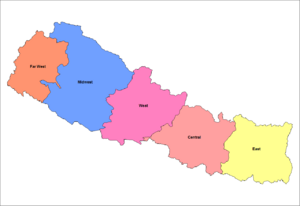Development Regions of Nepal facts for kids
Nepal is a beautiful country known for its mountains and diverse cultures. For many years, before September 20, 2015, Nepal was organized into different parts to help manage the country. These parts were called 5 Development Regions, along with 14 Administrative Zones and 75 Districts. Think of them like big sections that helped the government work better across the country. After 2015, Nepal changed its system and is now divided into 7 provinces and 77 districts. So, the Development Regions are no longer used today, but they were an important part of Nepal's history!
Nepal's Former Development Regions
Before the big change in 2015, Nepal had five main Development Regions. Each of these regions had its own capital city, which was like its main hub. These regions helped organize different parts of Nepal, from its eastern side to its far western areas.
Here's a quick look at the five regions that used to exist:
| Region | Nepali Name | Capital City | Population (2011) |
Area (km²) |
|---|---|---|---|---|
| Central | Madhyamanchal | Hetauda | 9,656,985 | 27,410 |
| Mid-Western | Madhya Pashchimanchal | Birendranagar | 3,546,682 | 42,378 |
| Western | Pashchimanchal | Pokhara | 4,926,765 | 29,398 |
| Eastern | Purwanchal | Dhankuta | 5,811,555 | 28,456 |
| Far-Western | Sudur Pashchimanchal | Dipayal | 2,552,517 | 19,539 |
Why Did Nepal Change Its Divisions?
Countries often change how they are divided to better serve their people or to make government more efficient. In 2015, Nepal adopted a new constitution. This new constitution brought about a big change, creating 7 new provinces and updating the number of districts to 77. This new system was designed to give local governments more power and to make sure that all parts of Nepal had a say in how the country was run. It was a big step in Nepal's journey to become a stronger, more organized nation.
Related pages


